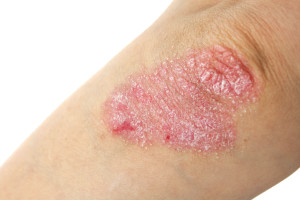 If you experience a deep bone ache in the joints that are warm to the touch accompanied by scaly red patches of skin that may even have a slightly sliver tint to them, you may be dealing with psoriatic arthritis.
If you experience a deep bone ache in the joints that are warm to the touch accompanied by scaly red patches of skin that may even have a slightly sliver tint to them, you may be dealing with psoriatic arthritis.
Psoriatic arthritis, which is a chronic form of arthritis, results from a malfunctioning immune system in an auto immune reaction (where the body mistakenly attacks itself). The abnormal response causes inflammation in your joints as well as overproduction of skin cells which shows as patchiness.
Though certain genetic markers have been found which point to this disease being genetic, it is not entirely clear as to why some people develop it. Other suspects are environmental, physically trauma related, and even viral or bacterial infections.
Other signifiers:
Psoriasis – developing psoriasis is the single greatest risk factor for developing psoriatic arthritis. 15% of people with skin level psoriasis will develop psoriatic arthritis.
Swelling of the fingers, toes and feet – psoriatic arthritis can cause extreme swelling off toes, feet and fingers. Pain is often present in the back of your heel or the soul of your foot as well. These are often some of the first signs of this form of arthritis. If your rings or shoes become too tight accompanied by achiness, you may want to visit your doctor.
Lower back pain – You may also experience inflammation of the joints between the vertebrae of your spine and pelvis which presents as lower back pain.
Chronic or intermittent – This form of arthritis may come and go in and out of remission or may be chronic and constant. If the latter, care is needed in order for damage to be minimized.
______________________________________________________________________
Note – Psoriatic arthritis usually will begin to develop between the ages of 30 and 50, though it can also begin more rarely in childhood.
How is it diagnosed?
In order to diagnose psoriatic arthritis, rheumatologists look for outward physical characteristics like swollen and painful joints as well as certain skin and nail changes. X-rays, MRI, ultrasound or CT scans can be used to look at the joints more closely. Misdiagnosis – Psoriatic Arthritis is sometimes misdiagnosed as gout, osteoarthritis or rheumatoid arthritis. Because of this, blood tests may also be done in order to rule out other types of arthritis.
Treatment
Though so far there is no cure for psoriatic arthritis, managing it is quite possible, especially if diagnosed in the early stages. If you are looking for a rheumatologist, please visit Independent Physicians Association of Lee County http://ipalc.org/ and search their database of qualified, verified and trusted physicians.
Share on Facebook




 Southwest Florida Medicine.com is dedicated to bringing you the very best health information available today!
Subscribe or check back regularly!
Southwest Florida Medicine.com is dedicated to bringing you the very best health information available today!
Subscribe or check back regularly!